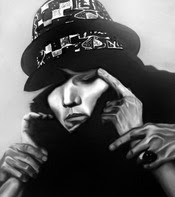
TUESDAY morning: December 11, 2007.
EddiE haRA, the artist who is now living in Basel, Switzerland, dropped to RSY. He has been in Indonesia for a few weeks relating to his solo exhibition – titled “Global Warming, Cool Art!”, December 5 through 18, 2007– at
Nadi Gallery, Jakarta. Enin Supriyanto is the curator of it. Expressing his closed-friendship to the artist, who is still look like a sitting-buddha, Enin wrote: Long live, you, fat ass artist!
I talked with the Salatiga – Central Java – born artist for hours. It was very great to speak to him. He speaks in the way Javanese priyayi (middle class well-educated people) always do: speaking slowly – not in a hurry – and polite. The way he speaks is quite different to his performance: wearing t-shirt and three-quarter loose pants, having an earing in his left-ear, and completed with red shoes. Old punk daddy. But now his head is not bold anymore. One thing is clear: his hair becoming silver. Sign: mature.
Then we had brunch: tahu pong. Tahu is beancurd. Pong is empty. Means: chruncy fried beancurd. This is a local dishes: fried beancurd served with garlic-sweet-kechup. Yummy.
After having meals we went to see a leading local art-collector. Such collector is usually called as ‘kolekdol’. Etymologically ‘kolekdol’ derives from ‘koleksi’ (means: to collect in Bahasa) and ‘dodolan’ (means: selling in Javanese). Kolekdol is a person who does collecting art works and in the same time selling them again. Just money-earning-oriented. In short, not a ‘pure’ art-collector. Aha, the term is specifically Indonesian.
But let’s talk about EddiE’s latest art-works. For more than centuries he is hoped by art critic and art lovers to change his childish iconic visual into something new and fresh. And this time is happened. Thank God. Though his new works are not entirely different than the old ones but now EddiE seems more enjoy with monocromatic colors. He puts stressing the objects with outlines. Rather simple. And more elegance.
Good luck, EddiE haRA. And allow me to rewrite (again) Enin’s phrase: Long live, you, fat ass artist!***













+of+DSC05301.jpg)




